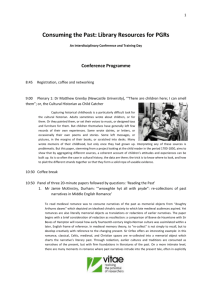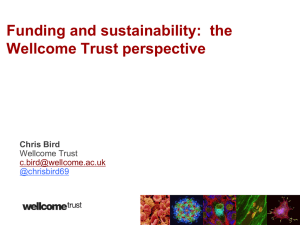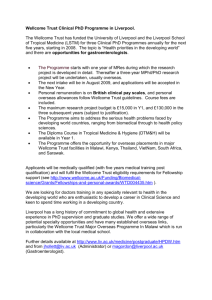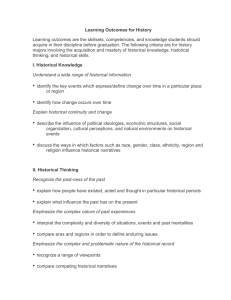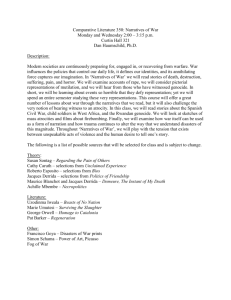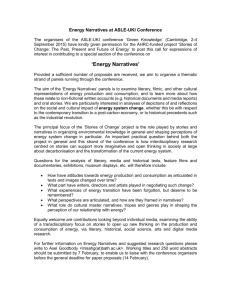Keynote address, Dr Matthew Grenby: Title TBC. Panel One
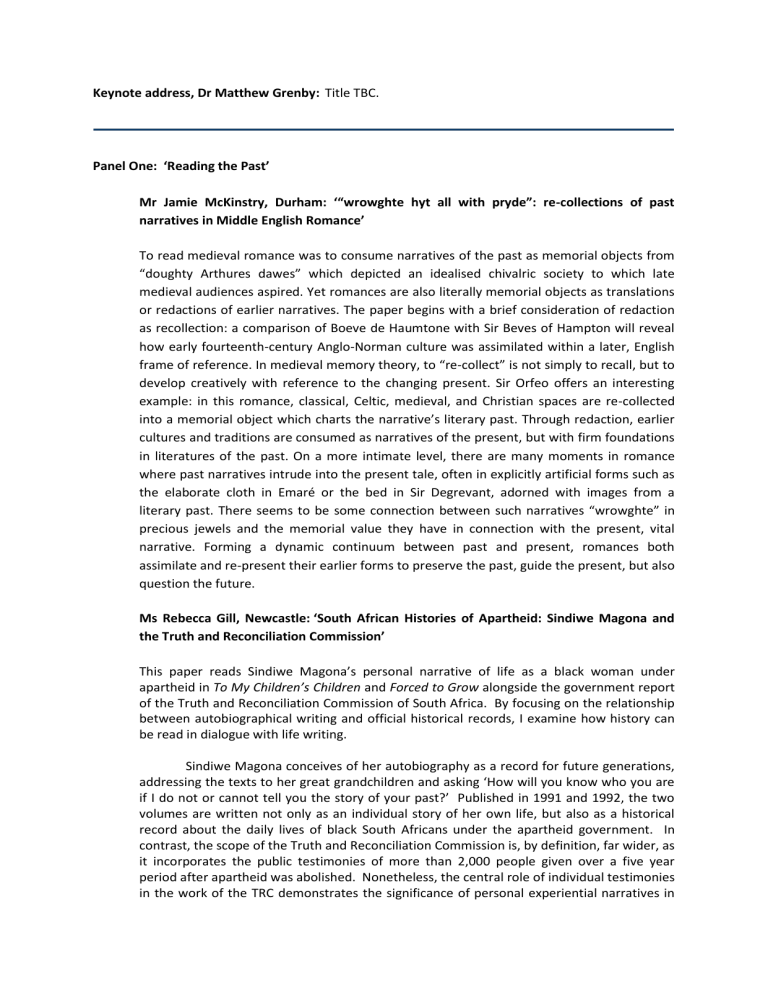
Keynote address, Dr Matthew Grenby: Title TBC.
Panel One: ‘Reading the Past’
Mr Jamie McKinstry, Durham: ‘“wrowghte hyt all with pryde”: re-collections of past narratives in Middle English Romance’
To read medieval romance was to consume narratives of the past as memorial objects from
“doughty Arthures dawes” which depicted an idealised chivalric society to which late medieval audiences aspired. Yet romances are also literally memorial objects as translations or redactions of earlier narratives. The paper begins with a brief consideration of redaction as recollection: a comparison of Boeve de Haumtone with Sir Beves of Hampton will reveal how early fourteenth-century Anglo-Norman culture was assimilated within a later, English frame of reference. In medieval memory theory, to “re-collect” is not simply to recall, but to develop creatively with reference to the changing present. Sir Orfeo offers an interesting example: in this romance, classical, Celtic, medieval, and Christian spaces are re-collected into a memorial object which charts the narrative’s literary past. Through redaction, earlier cultures and traditions are consumed as narratives of the present, but with firm foundations in literatures of the past. On a more intimate level, there are many moments in romance where past narratives intrude into the present tale, often in explicitly artificial forms such as the elaborate cloth in Emaré or the bed in Sir Degrevant, adorned with images from a literary past. There seems to be some connection between such narratives “wrowghte” in precious jewels and the memorial value they have in connection with the present, vital narrative. Forming a dynamic continuum between past and present, romances both assimilate and re-present their earlier forms to preserve the past, guide the present, but also question the future.
Ms Rebecca Gill, Newcastle: ‘South African Histories of Apartheid: Sindiwe Magona and the Truth and Reconciliation Commission’
This paper reads Sindiwe Magona’s personal narrative of life as a black woman under apartheid in To My Children’s Children and Forced to Grow alongside the government report of the Truth and Reconciliation Commission of South Africa. By focusing on the relationship between autobiographical writing and official historical records, I examine how history can be read in dialogue with life writing.
Sindiwe Magona conceives of her autobiography as a record for future generations, addressing the texts to her great grandchildren and asking ‘How will you know who you are if I do not or cannot tell you the story of your past?’ Published in 1991 and 1992, the two volumes are written not only as an individual story of her own life, but also as a historical record about the daily lives of black South Africans under the apartheid government. In contrast, the scope of the Truth and Reconciliation Commission is, by definition, far wider, as it incorporates the public testimonies of more than 2,000 people given over a five year period after apartheid was abolished. Nonetheless, the central role of individual testimonies in the work of the TRC demonstrates the significance of personal experiential narratives in
establishing a historical ‘truth’ as part of an official national record. By reading these very different records in dialogue with one another I explore the complex interrelation of personal memory, trauma testimony and public history in South Africa.
Ms Ellen Turner, Newcastle: ‘A Romance of Old Tasmania: Isabel Dick’s Wild Orchard’
Abstract TBC.
British Library Workshop
The British Library offers a vast range of resources for researchers, accessible both within the Library and online. The 14 million books the Library holds are just the beginning - you can find journals, newspapers, ancient manuscripts, photographs, sound recordings, video, personal letters, diaries, notebooks, official publications, patents and more. With such a bewildering array of resources, finding a pathway to material that is relevant to your research can be a daunting task. This workshop will explore some of the historical resources the Library holds and explain how to access them both within the Library and online (via digital collections such as Early English Books Online (EEBO) and Eighteenth Century
Collections Online (ECCO)).
Panel 2: ‘Accessing the Past’
Dr Wim Van Mierlo, London: ‘Historical Bibliography Is Dead; Long Live Historical
Bibliography’
In this paper I do not propose to go into the reasons why Historical Bibliography has disappeared from curricula during the past few decades, except to note its demise with regret. Instead, I want to focus on the changes that took place within the field of Historical
Bibliography (broadly defined) during the same period and the opportunities it offers for teaching and training at the postgraduate (but also undergraduate) level. What has become apparent, even when textual editing has moved away from “objectivist” notions of recovering final authorial intention in the Greg-Bowers-Tanselle paradigm to a more socialized concept of the literary text and work in the tradition of D.F. McKenzie, is that agency cannot be theorized out of existence. As the “making of the text”, the whole spectrum of writing, publishing, promoting and reading the work of literature, has informed the scholarly and editorial process, so the “making of the text” can inform classroom use. In particular in my specialism, the study of modern literary manuscripts, a vast array of resources exist from facsimile editions to electronic archives that can be productively used for teaching. These resources do not replace the original archival materials, but can suitably act as a substitute to explore issues of creativity, aesthetics and authorship. I propose to draw on some select examples (Keats, Rossetti, Yeats, Owen, Plath) to demonstrate how we
can turn students into “textually aware” readers without the need to inculcate them in the technical, seemingly esoteric detail normally associated with Historical Bibliography.
Mr Ross MacFarlane, Wellcome: ‘Digitisation, Web 2.0 and Research in the Wellcome
Library’
The Wellcome Library is Europe’s largest History of Medicine Library with a long-established role as a location for postgraduate research. In recent years, the Library has embarked on a number of projects to digitise clearly defined parts of its printed, manuscript, visual and moving image collections, and make them freely available through its website.
Examples of completed projects include Wellcome Film , which has digitised over 450 titles from the Library’s Moving Image and Sound Collection, and the project to digitise the largest extant collection of English 17 th century domestic remedy manuscripts . The
Wellcome Library has also embarked on a major collaboration with King’s College London and the Bibliotheca Alexandrina in Egypt to digitise the Wellcome’s Arabic manuscripts and has also started a major pilot programme on digitising archive papers with the theme,
'Modern Genetics and its Foundations ’.
Such projects do, however, raise challenging questions: will the nature of research undertaken in the Wellcome Library alter as a result of more material being available online?
Will digitisation open up new areas of research? Can digitisation offer a process of balancing the demands of academic researchers with attempts to reach new audiences?
As an indirect product of the Wellcome Library’s digitisation projects was the creation of a Library Blog , the paper will also discuss how web 2.0 offers opportunities to both publicise our work, but also develop new methods in interpreting our collections.
Mr Emmanuouil Kalkanis, Durham: ‘Notes on Eighteenth-Century Classical Art Collecting in the light of original correspondence: The case of Sir William Hamilton Papers’
Letters belong to archives and as archives they are the product of some activity of the past.
They sometimes tell untold stories about different things and different people reflecting emotions, unknown details and diverse ideas; but why do we read letters? Would it be possible to get a complete idea of the past simply by studying and analyzing them? In this paper I will examine letter writing and its role to the appropriation of the past through the voices of one man who has been regarded both as an influential diplomat and a passionate dilettante. Throughout his life, the letter becomes a key medium of business with antiquity.
Sir William Hamilton’s life, after 1764, when he reached Naples as the British Envoy to the Bourbon Court of the Two Sicilies, is adequately documented. He was much written about, and his surviving correspondence is voluminous. More than one hundred years after originally written, Alfred Morrison privately published the Hamilton and Nelson Papers (1893
– 4). These letters illuminate an interpretation of the past and its historic-cultural context in
terms of an individual’s conceptualization of a different collecting habit (Sir William
Hamilton was an avid collector of Greek vases).
My paper will explore how the past can be understood and appropriated on the basis of the above archival material. We cannot help but wonder how far is it possible to access the past through such correspondence, in this case the cultural history of collecting in the late eighteenth century. A series of questions emanates on the difficulty in accessing the past through the voices, thoughts and ideas of others and the extent to which the historical approach and interpretation of culture depends on these voices. By discussing some practical and theoretical issues arising from such a cross disciplinary study, I attempt a first step in determining the writer’s role in people’s perception of an affair with art and antiquity.
Keynote address: ‘Activism and Learning: The Lit & Phil and Slavery & Abolition’ (Sean Creighton, independent historian)
Newcastle's Literary & Philosophical Society Library was the lead partner in the 2007 Tyne and Wear Remembering Slavery Project. Founded in 1793, leading members were active in the abolition of the slave trade movement, and for emancipation through to 1838. Since
1793 it has built up an extensive library, including a major collection of tracts. Many of the tracts on slavery and abolition are not in digitised collections. The Library's wide range of books and other material provided invaluable additional information about the national, regional and local context. Sean will discuss the process of the research and its findings and share thoughts about issues that arose. An independent historian, among other historical activities, Sean is convenor of the North East Slavery & Abolition Group which continues the work of the Project.
